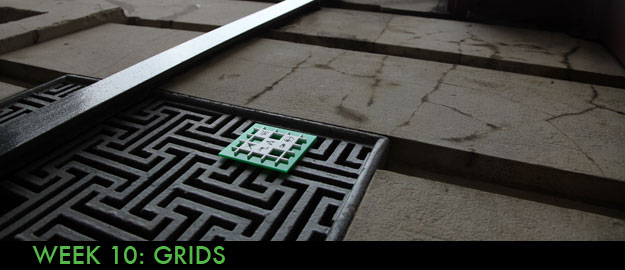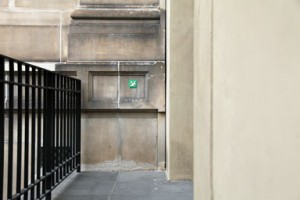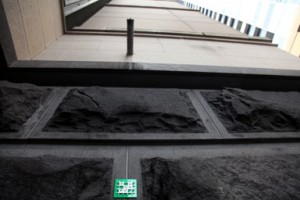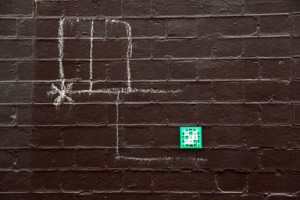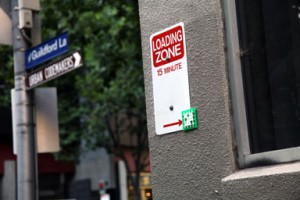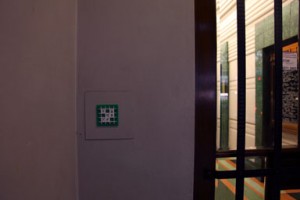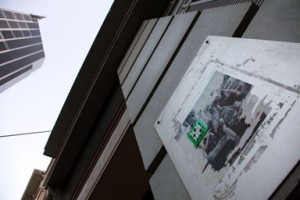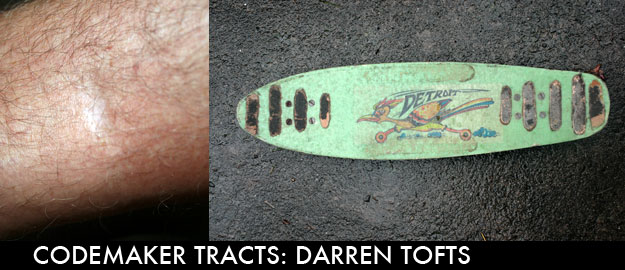::: sim == virus :::
Simulation
Week 10: Grids
The Master Codemaker is attempting to restore order to the city after the infection of the Urbanist’s virus. An infection that continues to slowly spread – new nodes appeared last night. Creatures identified by the Ecologist are also continuing to come out of the woodwork… only 19 days left and IDEOTAGs are appearing all over the grid of the city.
IDEOTAGs have been placed by the Master Codemaker along the lines of the grid. Each is encrypted with six symbols from the The Colophon Rippley Ti that point back to the origin of his ‘search for the Gelded Third Ho’. Collect an IDEOTAG from the city to observe these in detail. During the next two weeks the Master Codemaker will make possible the means to decode his codes. Watch these spaces.
In the meantime collect green IDEOTAGs as they appear in the city. Their placement is not abitrary. Lines connect the codes to map the origins of the City of Melbourne itself and inform the Master Codemaker’s Reclamation Project. It is rumoured that he will posting details of this shortly on his blog at http://mastercodemaker.com/… (now confirmed: Seek out Melbourne)
Archive 9: Virus
[nggallery id=11]
Hitting the deck: traversing the embodied city
In the dawn, armed with a burning patience, we shall enter the splendid Cities
Rimbaud
Darren Tofts ::: Swinburne University of Technology
I think it was around January ‘76. Lairising at speed I was upended by the resilient and time-worn inevitability of a road-side curb. A stray stone, one of the myriad instances of invisible urban kipple, chaperoned my fall back to terra firma, puncturing flesh in a tidy, almost surgical perforation. Both decks still exist, one in my garage and the other in reassuring situ on the corner of Russell and Bourke; respective testaments to the archive drive and the enduring social ecology of urban space. Despite the intervening years, that familiar coordinate has become a kind of intransitive verb, for in Melbourne you are always traversing Russell and Bourke. But this particular inscription was especially acute, since it is indelibly written on the body with the intimate longevity of a freckle.
If you look closely you can still see it. Just above the left ankle. A puncture mark that became infected, accelerated into septicemia and eventually degenerated into an ulcer that an intense course of penicillin could not assuage. For years it was numb, uncannily tactile yet resistant to the touch and the petulant agitation of sharpened fingernails. With the intervening years the nerves have repaired themselves, re-generated, like so many urban renewal projects.
Skateboarding was one of the first forms of play that re-defined the bland utilitarianism of urban infrastructure, radically altering its flows, its rhythms and its command and control of the street. In fact skateboarding was an incipient form of cyberpunk, finding its own use for things through accident, happenstance and casual opportunism. Stacey Peralta’s Dogtown and Z-Boys (2001) documented how the spillways and concrete wastelands of California were claimed by second generation skateboarders as a new kind of territory, aggressively re-purposed through the ballsy speed of a mobility that was different from walking, cycling or running and, for that matter, skateboarding as it had been understood up to that time. During the long drought of 1976 sidewalk flâneurs like Tony Alva and Jay Adams tactically invented new moves for and attitudes towards skateboarding by détourning people’s empty swimming pools in a form of fractious guerrilla aesthetics, an imaginative and gymnastic transit through confined and defined space, years before the notion of the skate bowl or vert had even been conceived.
In his splendid book on the pleasures of pedestrian Paris, The Flâneur, Edmund White insists that the City of Light “is a world meant to be seen by the walker alone, for only the pace of strolling can take in all the rich (if muted) detail”. Thinking back on my own experience as a sixteen year old, I would anachronistically concur with Monsieur White, with the qualification that a set of Cadillac polyurethane fats, Detroit trucks and a fibreglass flexi-deck make for an even smoother ride. Or, to appropriate and remix Charles Baudelaire on the figure of the city loiterer, the “observer is a prince who, riding a skateboard, takes pleasure everywhere”.
This small and apparently innocuous mark which I’ve carried around as part of me since the late 70s speaks of our almost forgotten corporeal relationship to the urban spaces we inhabit everyday and, in particular, the pleasures we derive from this relationship. I’m not simply talking about the everyday experience of “walking in the city”, as Michel de Certeau would have it. I’m talking about the residue of the street that builds up on the soles of your feet, the dust and fumes that irritate the mucous membrane, the seduction of the olfactory imagination with the aromas of grimy restaurant exhaust fans, caressing the air with the spunk of a dozen promiscuous cuisines. Far from being perambulatory, the experience of the street is a kind of tango, a hustle involving the physical negotiation of bodies in unavoidable, unwanted contact and the obscure, balletic attempts to avoid it or court it; the radiant heat and sweat oozing from buildings as they metabolize the atmospheric ebbs and flows of ancient diurnal rhythms.
This corporeal sensation of the built environment as a kind of rutting is almost forgotten because our first hand experience of the funk and rugged grit of the street has been intimately modified by the smooth wireless locutions of being elsewhere. The here and now has been seamlessly and effortlessly relegated to the status of regrettable background noise, an omnipresent there invoked by the intimate apparel of personalized mobile media. The hand-held screen has become a portal, the escape clause of a “grammar for being elsewhere” as the critic H. Porter Abbott might say, that persistently changes our relationship the stuff of the street.
The more sedentary pleasure of walking and talking in the city, gesticulating to absent, unseen others has replaced the vertiginous thrill of gunning it down the projectile grid of Melbourne’s unanimous streets and laneways. But the memories of that vibe are indelibly part of the streetscape that I move through every time I pound the pavement through my beloved vectoral Melbourne. Walking, like skateboarding, has its codes, its syntax of sensation and muscle memory, the diverse semantics of its lyrical strolling and delirious mediated speed. But a memory, mediated or otherwise, is quite different from and far more evocative than the telepresence of cellular telephony. Listen, I don’t care how piquant or memorable that SMS was that disengages you from the world. It ain’t no Madeleine dunked in tea and the uncontrolled wonders of memory it is capable of unleashing. I’m still acutely aware of the sonic residues that saturate my experience of the city, attuned to the tinny proximity of the trannie, the café muzak along Swanston Street and the formidable memory theatre that is the LP archive assembled from these very streets. Involuntarily I hear the varied, iconic echoes of Tony Christie’s “Through the avenues and alleyways” from myriad auditions as I haunt the sites of long-gone record stores like Archie ‘n Jugheads, Pipe, Gaslight and Batman, or vestigial second-hand bookshops that now serve bubble-tea, cheap porn, globalized coffee and Korean kitsch.
Skateboarding is a form of codemaking avant la lettre. It is a form of writing that weaves the city, integrates its threads as a kind of tapestry, the warp and weft of a continuous negotiation of discrete, GPS-precise locations into the flow, grace and rhythm of a kinetic mise en scène that is as uniquely individual to me as it is to countless conjugated yous. For years I have been photographing faded anachronistic advertising, logos and street paraphernalia in the Melbourne CBD as well as the northern suburbs in which I grew up and currently live. I realise now that this visual semiotic landscape is the sedimentary record of Melbourne’s corporate muscle memory, its remembrance of things past their use by date. But this overlap of the past with many successive presents is, like a heritage overlay, also a remembrance of things fast, a persistent algorithm that continues, and will continue, to entwine our immediate experience and memory of the urban landscape we call home.
Postscript, 12.29 am, 10/1/11.
I recently bought a pair of red suede Converse runners. A curious name, runners, since I very rarely run in them, though remember a younger self that did. What is most uncanny about them is the immediate association of a kind of movement more akin to dancing than running or even walking. But not dancing in the street, dancing the street, a sensation of gliding, bending and curving, a series of sculptural vogues riffing off the embodied city that transcend the mechanical, algorithmic binary of left/right. This is a different kind of code, a bio-spatial rumba that attunes you to a speed unlike anything cranked out by even the fastest dual core processors. When you are courted by its vibe, it’s time to hit the deck. I feel a Lygon Street limbo coming on.
Dedicated to Melbourne Sports Depot, Northland Shopping Centre, East Preston, c. 1975.
Breaking the code…
We were right to question where our gaze should fall. It should have, all the time, been focused not on the city but on the Crossmedia Ecologist and the Master Codemaker themselves. We see now, and our simulations back this up, that they all along have been working to prevent us from achieving our plans.
Where we were honest, they lied; where we hewed to transparency, they slipped into obfuscation; where we tried to bring something new into the world, they were content in playing with what was already there; where we observed and studied, they interfered.
This time is over. This experiment is over.
But we cannot allow it to be undertaken again – and we cannot allow it to be adopted, in part or in whole, by the others. We have run simulations on what they would do, and we believe that their influence would create a city hostile to the essential processes that a city needs, one which is built exclusively around play, or one which hides the true nature beneath layers of history and ephemera. And we, for our part, have seen it as a series of codes, deconstructing it into rules and fragments of information. This was a mistake. We three have all been utterly wrong. None of us is the correct way for a system – a city – to be healthy. Our simulations have shown this, our programs have shown this. As individuals in conflict, what we created was half-formed, howling unheard into the sky. The life that we brought into this world is incomplete, barely conscious, without rhyme or reason or purpose.
So we have decided to give it one before we can no longer support it.
Operatives have begun running a slightly modified program in the city – a tweaked variable, a few new lines of code, a minor function added – that will change the emerging consciousness. It has only a short amount of time left before it disappears completely into the dust, like all life, and we don’t know how long that might be. What we do know is that we can guide it, coax it out, make its tiny life burn oh so bright. It is not quite a virus, although I’m sure the other guilds will see it that way, but it is hostile – to all three of us, which they are free to take or leave as some small consolation.
It is time. It is time the city was left to its inhabitants, not to its observers. It is time that the process we began was brought to an end. It is time to leave.
